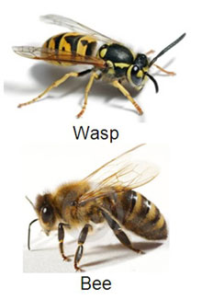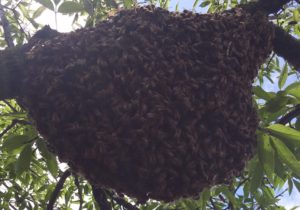Swarm &
Bee Removal
Why call a beekeeper to re-home your
nuisance honey bees?
The honey bee population has had an ever increasing struggle to survive in recent years. Many beekeepers are getting out of business because of the difficulty in keeping them alive over winter. Honey bees, and other pollinators are essential for flowers, flowering shrubs, and some say anywhere from 30-60% of the food we eat such as fruits and vegetables, plus the pasture that our meat sources eat requires pollination by honey bees.
You can call us to re-home the honey bees currently on your property to a hive setup where they will be taken care of and where they won’t be a nuisance to you or your neighbors.
First, you need to determine if the insect we are looking at is actually a honey bee. Honey bees are fuzzy and are a light brown and dark brown. Please take a good look at this picture for positive identification. They can be darker or lighter than this picture depending on the strain of bees they are. If it is bright yellow and shiny, it’s not a honey bee! We only remove honey bees, not wasps or hornets of any kind. Save yourself a trip fee by knowing the difference. If it is not honey bees, you should call an exterminator who can safely use chemicals we are not licensed or trained to use.

What is a ‘swarm’ of honey bees?

Spring and early summer is when you are most likely to see a swarm of honey bees. If you see a cluster of honey bees like the pictures here on a branch or structure, this is a swarm. When certain conditions exist, a colony of honey bees will make a new queen and the old queen and around half of the workers leave the hive to find a new home. This is nature’s way of increasing and continuing the species.
This is a GREAT time to capture them and put them in a hive setup where they will have everything they need to survive and thrive. We will remove swarms like these from your property for FREE within our service area*.
Please understand that once the honey bees move into a non-movable or openable structure, we have to charge a fee to open the structure and remove them. Please give us a call to for an estimate and to schedule a job. Honey bees on a branch or exterior surface NOT inside a structure qualifies for free removal as the process requires no opening of a home or building, and usually the process takes around an hour. Swarms not in a structure have a higher success rate of surviving than a ‘cut out’ job. As a professional beekeeper, bees are valuable to us, but so is our time. Because honey bees established and removed from a structure have a higher probability of not surviving and takes longer to remove, we do need to get reimbursed for the time spent
April, May, and June are the best times to remove a colony (hive) from your structure as there is less honey in the comb because they have consumed a large portion of it to survive the winter. Removing them early in the season gives them the best chance to get acclimated to their new home, build combs to raise new bees, and store food for the upcoming winter. If we remove them in late summer or fall when nectar (the floral source that honey is made from) is in short supply or not available, it makes it much harder for the honey bee colony to survive the cold months.
Swarms can cluster on a branch, a mailbox, a fence, or anything really! They are very docile at this time as they don’t have any babies, food, or a home to protect. A careful beekeeper doesn’t even need protective gear like a veil and gloves to move them to a hive in many cases! While there is nothing to fear, the swarm will not stick around long! Call as soon as you can so we can collect them before they move into a structure of yours or your neighbor’s!
*Service area is 20 miles from Big Bend WI, and includes Big Bend, Vernon, Muskego, Waterford, Burlington, Rochester, East Troy, New Berlin, Union Grove, Eagle, Palmyra, North Prairie, Wales, Genesee Depot, Waukesha, Hales Corners, Franklin, Wind Lake, Tichigan, and others.
